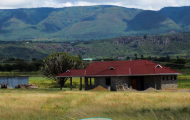Submitted by Guest on Tue, 2014-09-30 13:57

- STORIES FROM MAAI MAHIU, KENYA -
As we wrap up our month of celebrating Café UBUNTU and all that it stands for, we'd like to share a guest blog from Amara Watkin-Anson. Amara spent some time with us in Maai Mahiu and helped shape the long-term health and nutritional focuses of the Café, put together the pilot composting program with local restaurants and hotels and added to our efforts in teaching sustainable farming methods. Her blog is about the importance of the Café's focus on health, nutrition, and sustainable food sourcing.
Guest Blog By: Amara Watkin-Anson
If we speak of healthy communities, we cannot be speaking of a community that is merely human. We are talking about a neighborhood of humans in a place, plus the place itself: its soil, its water, its air, and all the families and tribes of nonhuman creatures that belong to it. If the place is well preserved, if its entire membership, natural and human, is present in it, and if the human economy is in practical harmony with the nature of the place, then the community is healthy…A healthy community is sustainable; it is, within reasonable limits, self-sufficient and, within reasonable limits, self-determined—that is, free of tyranny.[1]
– Wendell Berry
To understand a healthy community, we must understand both our limits as well as our relationships that inform identity, connectivity, and sustainability. If we understand this premise, we can ensure that our landscapes (economic, social, political, cultural and environmental) are “sustainable and abundantly productive” by “maintaining in them a living formal complexity something like that of natural ecosystems”.[2]
At Café UBUNTU, we are working to create that change- shifting the way in which we think about food as not just mere items on a plate, but rather, energy that fuels and is part of a larger system. By focusing on producing ingredients on UBUNTU farm that are of the highest quality, and combining them in the most natural and healthy way, we can begin to give our community and ourselves the true nourishment that we need.
Most would agree that a tomato tastes best when picked red from the vine (rather than green for transport). So by recognizing that food tastes better (and is actually nutritionally better for you) when it is eaten in season, we have begun to design a menu that takes seasonality into account. Food should taste good and be good for you!
At a time when communities across the globe are faced with the increasing threat of industrialized agriculture and ecological upheaval, we must think big, and loud, and bold. Leveraging our resources and recognizing that the health of a community relies on the health of all of its sectors is imperative. Across culture and generations, food brings people together. We must understand the cultural landscape in order to affect change in any sector, and giving communities the tools and resources to develop this for themselves is essential. As facilitators and solution seekers, we must not attempt to provide all of the answers, but rather ask the right questions and provide examples so that people can discover alternatives themselves.

